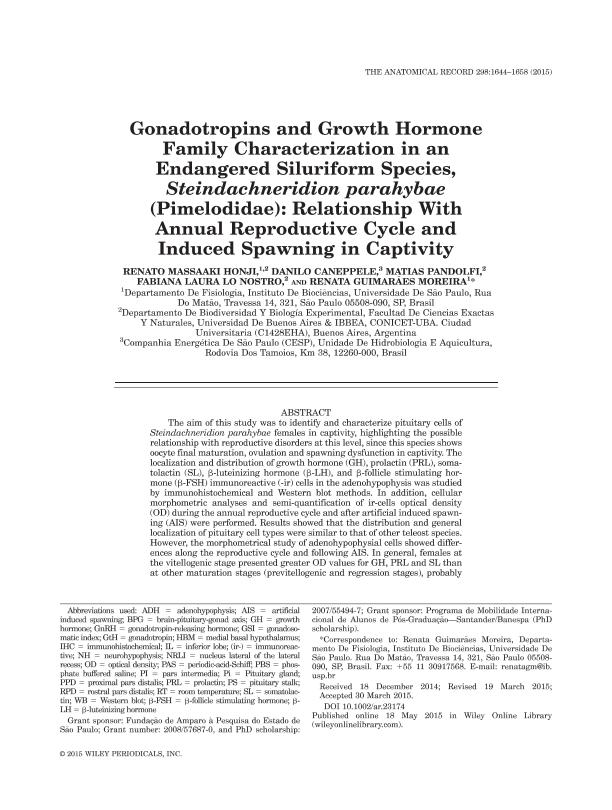Artículo
Gonadotropins and Growth Hormone Family Characterization in an Endangered Siluriform Species, Steindachneridion parahybae (Pimelodidae): Relationship With Annual Reproductive Cycle and Induced Spawning in Captivity
Honji, Renato Massaaki ; Caneppele, Danilo; Pandolfi, Matias
; Caneppele, Danilo; Pandolfi, Matias ; Lo Nostro, Fabiana Laura
; Lo Nostro, Fabiana Laura ; Moreira, Renata
; Moreira, Renata
 ; Caneppele, Danilo; Pandolfi, Matias
; Caneppele, Danilo; Pandolfi, Matias ; Lo Nostro, Fabiana Laura
; Lo Nostro, Fabiana Laura ; Moreira, Renata
; Moreira, Renata
Fecha de publicación:
09/2015
Editorial:
Wiley
Revista:
Anatomical Record-advances In Integrative Anatomy And Evolutionary Biology
ISSN:
1932-8486
Idioma:
Inglés
Tipo de recurso:
Artículo publicado
Clasificación temática:
Resumen
The aim of this study was to identify and characterize pituitary cells of Steindachneridion parahybae females in captivity, highlighting the possible relationship with reproductive disorders at this level, since this species shows oocyte final maturation, ovulation and spawning dysfunction in captivity. The localization and distribution of growth hormone (GH), prolactin (PRL), somatolactin (SL), b-luteinizing hormone (b-LH), and b-follicle stimulating hormone (b-FSH) immunoreactive (-ir) cells in the adenohypophysis was studied by immunohistochemical and Western blot methods. In addition, cellular morphometric analyses and semi-quantification of ir-cells optical density (OD) during the annual reproductive cycle and after artificial induced spawning (AIS) were performed. Results showed that the distribution and general localization of pituitary cell types were similar to that of other teleost species. However, the morphometrical study of adenohypophysial cells showed differences along the reproductive cycle and following AIS. In general, females at the vitellogenic stage presented greater OD values for GH, PRL and SL than at other maturation stages (previtellogenic and regression stages), probably indicating an increased cellular activity during this stage. Conversely, b-LH OD did not vary during the annual reproductive cycle. After AIS, b-LH, SL and GH ir-cells showed an increase in OD values suggesting a possible involvement on oocyte final maturation, ovulation and spawning or a feedback control on the brain-pituitary-gonads axis. Reproductive dysfunction in S. parahybae females in captivity may be due to alteration of the synthesis pathways of b-LH. In addition, GH family of hormones could modulate associated mechanisms that influence the reproductive status in this species.
Archivos asociados
Licencia
Identificadores
Colecciones
Articulos(IBBEA)
Articulos de INSTITUTO DE BIODIVERSIDAD Y BIOLOGIA EXPERIMENTAL Y APLICADA
Articulos de INSTITUTO DE BIODIVERSIDAD Y BIOLOGIA EXPERIMENTAL Y APLICADA
Citación
Honji, Renato Massaaki; Caneppele, Danilo; Pandolfi, Matias; Lo Nostro, Fabiana Laura; Moreira, Renata; Gonadotropins and Growth Hormone Family Characterization in an Endangered Siluriform Species, Steindachneridion parahybae (Pimelodidae): Relationship With Annual Reproductive Cycle and Induced Spawning in Captivity; Wiley; Anatomical Record-advances In Integrative Anatomy And Evolutionary Biology; 298; 9; 9-2015; 1644-1658
Compartir
Altmétricas
Items relacionados
Mostrando titulos relacionados por título, autor y tema.
-
Di Yorio, María Paula ; Pérez Sirkin, Daniela Irina ; Delgadin, Tomás Horacio ; Shimizu, A.; Tsutsui, K.; Somoza, Gustavo Manuel ; Vissio, Paula Gabriela (Wiley Blackwell Publishing, Inc, 2016-05)
-
Susperreguy, Sebastian ; Muñoz, Liliana; Tkalenko, Natalia Y.; Mascanfroni, Ivan Darío ; Alamino, Vanina Alejandra ; Montesinos, Maria del Mar ; Masini, Ana María; Miras, Mirta Beatriz; Pellizas, Claudia Gabriela (Wiley Blackwell Publishing, Inc, 2011-03)
-
Ayala, Carolina ; Celis, Mara Ester (Expert Reviews Ltd., 2010-07)



